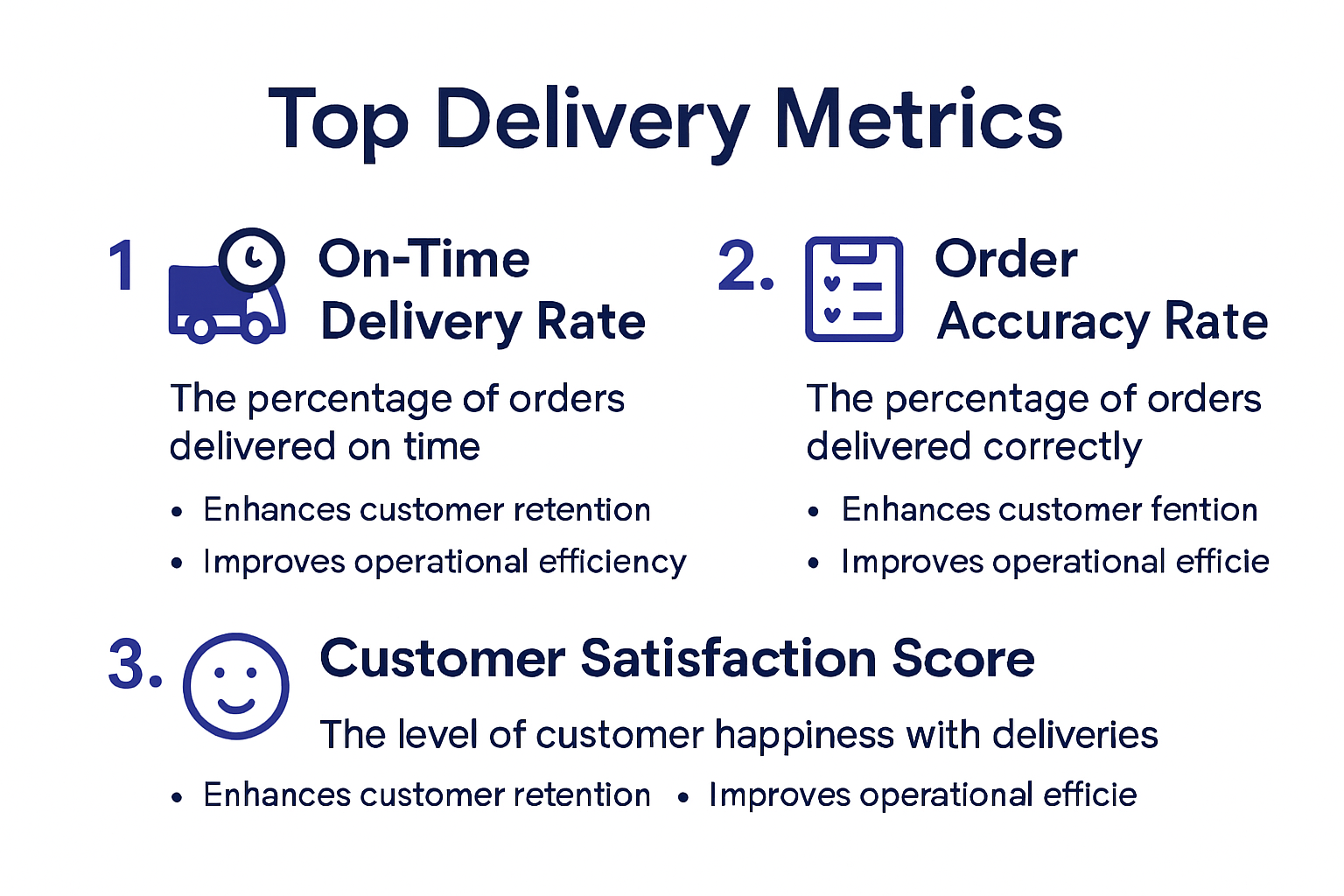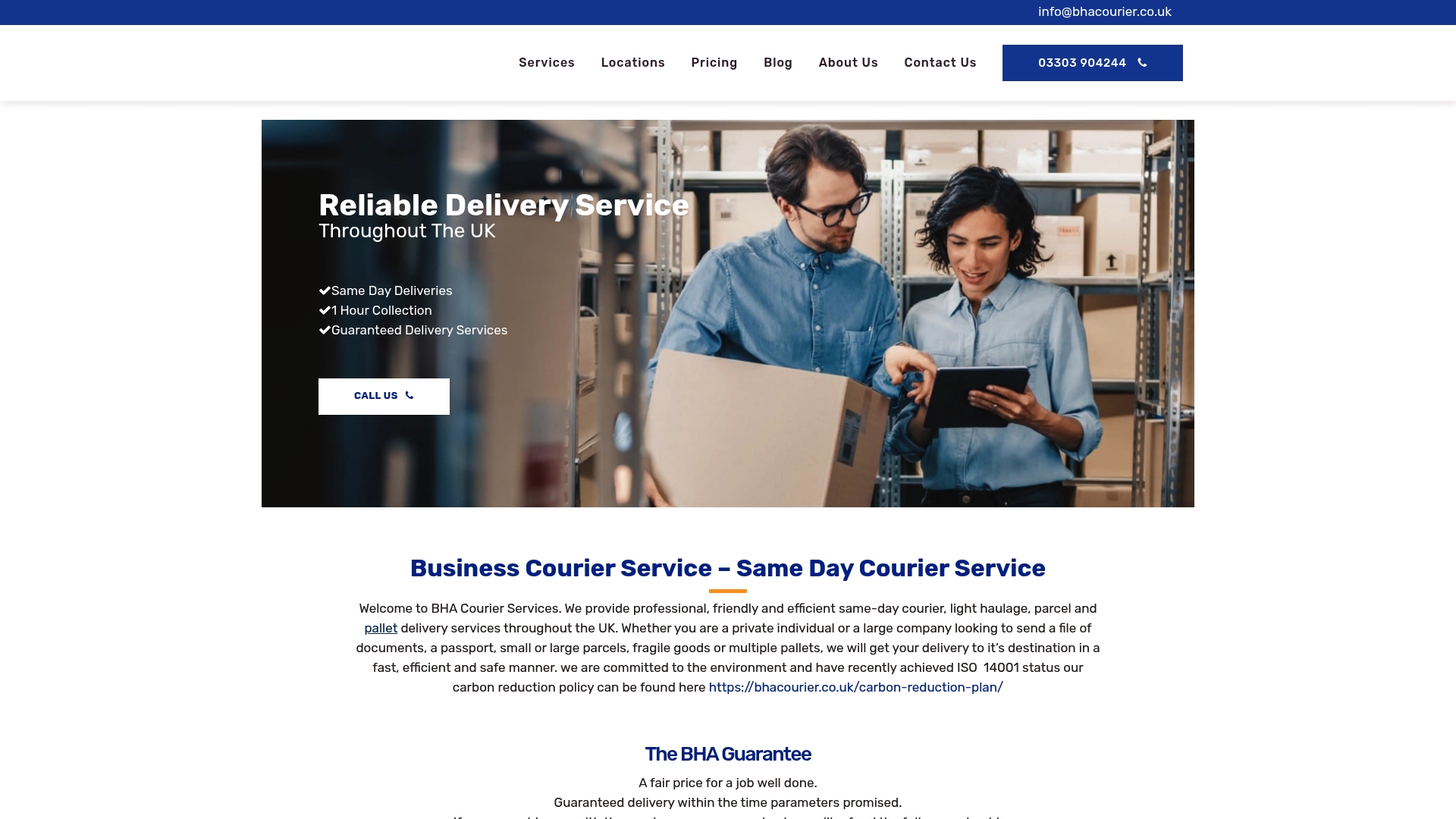
08 Jul Delivery Performance Metrics for UK Businesses in 2025

UK businesses are facing intense pressure to keep customers happy and speed up deliveries as we move into 2025. Here is something that may make you pause. Companies that track and respond to performance metrics can actually improve customer retention rates by up to 25 percent. Most think better performance means more money spent, but the truth is smart tracking can save costs and make operations smoother at the same time.
Table of Contents
- Essential Delivery Performance Metrics To Track
- Performance Measurement Fundamentals
- Advanced Tracking And Analytics
- Cost And Efficiency Considerations
- How To Measure And Interpret Delivery Data
- Data Collection And Standardisation
- Advanced Analytics And Interpretation
- Performance Visualization And Reporting
- Improving Delivery Outcomes For UK Businesses
- Strategic Performance Enhancement
- Data-Driven Performance Improvement
- Customer-Centric Delivery Strategies
- Choosing The Right Tools For Your Business
- Technology Selection Criteria
- Advanced Performance Management Technologies
- Implementation And Training Strategies
Quick Summary
| Takeaway | Explanation |
|---|---|
| Track Core Metrics | Focus on key performance indicators such as On-Time Delivery Rate, Order Accuracy Rate, and Customer Satisfaction Score to enhance operational efficiency and customer satisfaction. |
| Leverage Advanced Analytics | Utilize technologies like AI and machine learning to predict delivery challenges and optimise performance through advanced tracking systems. |
| Implement Cost Control Strategies | Consider financial metrics such as Cost per Delivery and Average Delivery Time to reduce operational costs while improving delivery outcomes. |
| Adopt Customer-Centric Approaches | Develop personalised delivery options and improve communication channels to align delivery performance with customer expectations for better satisfaction. |
| Choose Scalable Tools | Select performance management tools that are scalable, integrate well with existing systems, and offer real-time analytics to drive operational improvements. |
Essential Delivery Performance Metrics to Track
In the rapidly evolving logistics landscape of 2025, UK businesses must strategically track delivery performance metrics to maintain competitive advantage and customer satisfaction. Understanding and optimising these key indicators will be crucial for businesses seeking to streamline their delivery operations and meet increasingly demanding customer expectations.
Performance Measurement Fundamentals
Delivery performance metrics provide a comprehensive view of a company’s operational efficiency and customer service quality. According to McKinsey & Company, businesses that effectively track and respond to performance metrics can improve customer retention rates by up to 25%.
The core delivery performance metrics businesses should focus on include:
-
On-Time Delivery Rate: Measures the percentage of deliveries completed within the promised timeframe. A high on-time delivery rate indicates reliability and operational precision.
-
Order Accuracy Rate: Tracks the percentage of orders delivered without errors, directly impacting customer satisfaction and reducing return costs.
-
Customer Satisfaction Score: Evaluates overall customer experience through direct feedback and rating systems.

To help clarify the fundamental delivery performance metrics and their significance for UK businesses, the following table summarises each key metric and what it measures.
| Metric | What It Measures |
|---|---|
| On-Time Delivery Rate | Percentage of deliveries made within the promised timeframe |
| Order Accuracy Rate | Percentage of orders delivered without errors |
| Customer Satisfaction Score | Overall experience and satisfaction as rated by customers |
| Cost per Delivery | Operational cost incurred on each delivery |
| Average Delivery Time | Mean time taken to complete a delivery |
| Resource Utilisation Rate | Efficiency of resource deployment throughout the delivery process |
Advanced Tracking and Analytics
Modern businesses are increasingly leveraging advanced technologies to track delivery performance metrics. Gartner Research suggests that artificial intelligence and machine learning can help companies predict and improve delivery performance with unprecedented accuracy.
Implementing sophisticated tracking systems allows businesses to:
- Identify bottlenecks in delivery processes
- Predict potential delivery challenges
- Develop proactive strategies to enhance performance
For businesses looking to optimise their delivery strategies, our comprehensive guide on choosing courier services provides additional insights into selecting the right delivery partners.
Cost and Efficiency Considerations

Beyond tracking performance, businesses must also consider the financial implications of their delivery metrics. PwC research indicates that companies that effectively manage delivery performance can reduce operational costs by up to 15% while improving customer satisfaction.
Key financial metrics to consider include:
- Cost per delivery
- Average delivery time
- Resource utilisation rates
By implementing a comprehensive approach to tracking delivery performance metrics, UK businesses can enhance their operational efficiency, reduce costs, and ultimately provide superior customer experiences in the competitive 2025 marketplace.
How to Measure and Interpret Delivery Data
Measuring and interpreting delivery data is a critical process for UK businesses seeking to optimise their logistics performance and customer satisfaction in 2025. Effective data analysis requires a strategic approach that goes beyond simple number crunching and transforms raw information into actionable insights.
Data Collection and Standardisation
The foundation of effective delivery data measurement begins with robust data collection methodologies. According to Deloitte’s Logistics Performance Research, businesses must establish standardised data collection protocols to ensure consistency and comparability across different delivery channels and operational units.
Key considerations for data collection include:
- Automated Data Capture: Implementing technology that captures real-time delivery information
- Comprehensive Tracking: Recording multiple touchpoints throughout the delivery process
- Consistent Metrics: Developing uniform measurement standards across all delivery operations
The following table presents an overview of best practices for data collection and standardisation in delivery performance tracking, as outlined in the article.
| Practice | Description |
|---|---|
| Automated Data Capture | Use of technology for real-time capture of delivery data |
| Comprehensive Tracking | Recording multiple touchpoints across the delivery process |
| Consistent Metrics | Applying uniform standards and definitions for all delivery metrics |
Advanced Analytics and Interpretation
Modern businesses are moving beyond traditional performance metrics to more sophisticated data interpretation techniques. Gartner’s Supply Chain Analytics Report highlights that companies leveraging advanced analytics can improve their delivery performance by up to 35%.
Advanced interpretation strategies include:
- Predictive modeling to forecast potential delivery challenges
- Machine learning algorithms that identify performance patterns
- Comparative analysis across different operational segments
For businesses seeking deeper insights into optimising their delivery processes, our comprehensive guide on courier services provides additional strategic recommendations.
Performance Visualization and Reporting
Transforming complex delivery data into comprehensible insights is crucial for effective decision-making. PwC’s Digital Transformation in Logistics Study emphasises the importance of creating clear, actionable visualisations that communicate performance metrics effectively.
Effective reporting techniques include:
- Interactive dashboards showing real-time performance metrics
- Trend analysis highlighting long-term performance trajectories
- Comparative reports demonstrating operational improvements
By implementing a comprehensive approach to measuring and interpreting delivery data, businesses can transform raw information into strategic insights. This approach enables continuous improvement, supports data-driven decision-making, and ultimately enhances overall operational efficiency in the competitive logistics landscape of 2025.
Improving Delivery Outcomes for UK Businesses
UK businesses are increasingly recognising the critical importance of strategic approaches to enhancing delivery performance in the competitive 2025 marketplace. Improving delivery outcomes requires a multifaceted strategy that combines technological innovation, operational efficiency, and customer-centric methodologies.
Strategic Performance Enhancement
According to the National Audit Office’s report on Operational Capability, businesses must adopt a whole-system approach to improve delivery outcomes. This involves understanding complex operational demands and embedding systematic innovation across all delivery processes.
Key strategies for performance enhancement include:
- Continuous Process Optimization: Regularly reviewing and refining delivery workflows
- Technology Integration: Implementing advanced tracking and management systems
- Skill Development: Investing in staff training and capabilities
Data-Driven Performance Improvement
Office for National Statistics research demonstrates a direct correlation between management practices and business productivity. Businesses that leverage data-driven insights can potentially increase their operational efficiency by up to 15%.
Critical data-driven improvement techniques include:
- Predictive analytics for demand forecasting
- Real-time performance monitoring
- Comprehensive performance benchmarking
Our comprehensive business courier services provide advanced solutions for businesses seeking to transform their delivery operations.
Customer-Centric Delivery Strategies
The UK Government’s Evaluation and Performance Analysis Strategy emphasizes the importance of aligning operational improvements with customer expectations.
Customer-focused improvement approaches include:
- Personalised delivery options
- Transparent communication channels
- Flexible delivery scheduling
- Proactive problem resolution mechanisms
Businesses that successfully implement these strategies can expect significant improvements in customer satisfaction, operational efficiency, and overall competitive positioning. By adopting a holistic approach to delivery performance, UK businesses can create robust, adaptable delivery systems that meet the complex demands of the modern marketplace.
Choosing the Right Tools for Your Business
Selecting the appropriate tools for delivery performance management is a critical decision for UK businesses in 2025. The right technological solutions can transform operational efficiency, providing comprehensive insights and driving strategic improvements across delivery ecosystems.
Technology Selection Criteria
Choosing delivery performance tools requires a strategic approach. According to the Government Project Delivery Function Strategy, businesses must prioritise tools that offer flexibility, integration capabilities, and robust data analysis features.
Key selection criteria include:
- Scalability: Tools that can grow with your business
- Integration Capabilities: Seamless connectivity with existing systems
- Real-Time Analytics: Comprehensive performance monitoring
- User-Friendly Interface: Minimal training requirements
Advanced Performance Management Technologies
UK Statistics Authority research highlights the importance of sophisticated digital tools in enhancing service delivery. Modern businesses should consider technologies that offer:
- Artificial intelligence-powered predictive analytics
- Machine learning algorithms for performance optimization
- Cloud-based performance tracking systems
- Automated reporting and visualization tools
Our comprehensive business courier services provide cutting-edge technological solutions designed to meet evolving business needs.
Implementation and Training Strategies
Successful tool adoption extends beyond technological selection. The NHS Oversight Framework emphasizes the critical role of comprehensive implementation strategies and ongoing staff training.
Effective implementation approaches include:
- Phased rollout of new technologies
- Comprehensive staff training programmes
- Continuous performance monitoring
- Regular system updates and refinements
Businesses must view technological tools as strategic investments rather than mere operational expenses. By carefully selecting, implementing, and maintaining advanced performance management technologies, UK businesses can create robust, adaptive delivery systems that provide competitive advantages in the dynamic 2025 marketplace.
Frequently Asked Questions
What are the essential delivery performance metrics for UK businesses in 2025?
Key delivery performance metrics include On-Time Delivery Rate, Order Accuracy Rate, Customer Satisfaction Score, Cost per Delivery, Average Delivery Time, and Resource Utilisation Rate. Tracking these metrics is crucial for improving operational efficiency and maintaining customer satisfaction.
How can advanced analytics improve delivery performance for businesses in the UK?
Advanced analytics, including AI and machine learning, can help businesses predict delivery challenges, identify bottlenecks, and develop proactive strategies, thus significantly enhancing delivery performance and efficiency.
What are some strategies for improving delivery outcomes for UK businesses?
Businesses can improve delivery outcomes through continuous process optimisation, technology integration, staff training, and implementing customer-centric delivery strategies such as personalised options and transparent communication.
How should UK businesses choose the right tools for managing delivery performance metrics?
UK businesses should select tools based on scalability, integration capabilities with existing systems, real-time analytics, and user-friendly interfaces. Advanced technologies, such as AI-driven predictive analytics, are also vital for optimising performance management.
Transform Your Delivery Metrics into Real Results with BHA Courier
If you are feeling the strain of meeting modern delivery expectations and need to boost your on-time delivery rates and customer satisfaction, it is time to make a practical change. As highlighted in the article “Delivery Performance Metrics for UK Businesses in 2025,” tracking and improving key metrics like on-time delivery, order accuracy, and customer experience can make all the difference to your business. But knowing what to measure is only half the solution. You need a reliable partner who can consistently deliver the results your customers expect.

Do not let unreliable deliveries hold your business back. Visit BHA Courier to explore secure, rapid, and efficient courier services that support your delivery targets and satisfy demanding clients. Ready to leave late arrivals and mistakes behind? Learn how our business courier solutions can help you meet and exceed every delivery performance goal—get in touch now and take your operations to the next level.
Recommended
- BHA Couriers BHA Couriers Blog – Same Day Delivery Across The UK
- BHA Couriers South East | Dedicated Delivery
- Business Courier Service – Same Day Courier Service – BHA Couriers
- How to Choose a Courier Service | BHA Couriers
- Passport & Legal Document Courier Service – BHA Couriers
- BHA Couriers East Midlands | Dedicated Delivery

Sorry, the comment form is closed at this time.